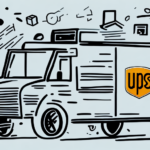Understanding UPS Shipping Insurance Rates
When shipping packages with UPS, obtaining coverage for loss or damage to your items is essential, especially when dealing with valuable or fragile items. Understanding UPS shipping insurance rates is crucial for anyone sending goods within the United States or internationally. In this article, we delve into the details of UPS shipping insurance rates, the importance of insurance, and essential information on filing claims and accurately declaring the value of your shipment.
Why You Need UPS Shipping Insurance
Accidents can happen during transit, leading to lost or damaged packages. UPS shipping insurance offers protection and peace of mind against such unforeseen events. While UPS handles packages with care, they cannot guarantee 100% safety during transportation. Without insurance coverage, you may face financial loss if your package is lost, stolen, or damaged beyond repair.
Moreover, UPS shipping insurance can cover the cost of customs duties and taxes for international shipments. This is particularly beneficial for businesses or individuals frequently shipping goods across borders, helping to avoid unexpected expenses and ensuring packages arrive safely and on time.
According to the U.S. Department of Transportation, the rate of package loss during transit is approximately 1%, highlighting the importance of shipping insurance.
How to Calculate UPS Shipping Insurance Rates
The cost of UPS shipping insurance is determined by the declared value of the package. To calculate the insurance rate, determine the total value of the items being shipped. UPS offers coverage for packages valued up to $50,000. Shipping insurance rates are based on a flat rate per each $100 of declared value and vary depending on the origin and destination of the shipment.
It's important to note that UPS shipping insurance covers the declared value of the package and does not include additional costs such as shipping fees or taxes. Additionally, certain items may not be eligible for coverage, including antiques, artwork, and jewelry. Carefully review UPS's terms and conditions for shipping insurance before sending high-value items.
- Declare the total value of your items
- Understand the rate per $100 of declared value
- Consider origin and destination factors
By utilizing UPS’s shipping calculator tool, you can easily determine the exact insurance rate for your specific shipment options.
The Factors That Determine UPS Shipping Insurance Rates
Several factors influence UPS shipping insurance rates, including:
- Shipping Distance: The distance between the origin and destination affects the insurance rate. Longer distances may incur higher rates.
- Shipment Weight and Contents: Heavier packages or those containing valuable contents can lead to higher insurance costs.
- Packaging Type: Proper packaging can reduce the risk of damage, potentially lowering insurance rates.
- Delivery Service Type: The chosen delivery speed and service level can impact the insurance rate.
- Declared Value: The higher the declared value, the higher the insurance rate.
- Destination Country: International shipments to certain countries with higher risks may have increased insurance rates.
Additionally, UPS offers specialized insurance options for high-value shipments, such as Declared Value Coverage, allowing shippers to declare a higher value than the actual value, and UPS Proactive Response Secure, which provides extra protection and monitoring for high-value packages. These options offer enhanced security for valuable items, ensuring comprehensive protection during transit.
What is Covered by UPS Shipping Insurance?
UPS shipping insurance generally covers loss or damage to packages during transit, including during transportation and delivery. However, there are exclusions such as losses resulting from natural disasters, acts of terrorism, or other major events beyond UPS’s control. It is crucial to review the UPS shipping insurance policy for specific terms and conditions.
In addition to covering the loss or replacement of items, UPS shipping insurance may also cover the cost of repairing or replacing damaged goods, which is particularly important for high-value or fragile items requiring special handling during shipping.
Another key aspect is liability protection. If your shipment causes damage or injury to a third party during transit, UPS may cover the cost of resulting legal claims or settlements. However, this type of coverage might not be included in all UPS insurance policies and could require additional fees or special arrangements.
What is Not Covered by UPS Shipping Insurance?
There are specific items that UPS shipping insurance does not cover, or offers limited coverage for, including:
- Artwork, furs, and jewelry
- Perishable goods
- Hazardous materials
- Antiques and collectibles
- Rare books
It's essential to declare the contents of your package accurately when shipping and verify with the UPS insurance policy regarding excluded items.
Furthermore, UPS shipping insurance may not cover losses or damages resulting from specific circumstances like natural disasters or acts of terrorism. In such cases, UPS might offer limited coverage or none at all, thus reviewing the insurance policy carefully and considering additional insurance is advisable for high-risk shipments.
How to File a Claim for UPS Shipping Insurance
To file a claim for UPS shipping insurance, follow these steps:
- Report the damage or loss as soon as possible through the UPS website or by contacting their customer service center.
- Provide necessary documentation as per UPS’s guidelines, including evidence of loss or damage.
- UPS may require an inspection of the damaged package and its contents before approving the claim, so retain the package and all contents until the claim is resolved.
- Once the claim is filed, UPS will review the provided documentation and may request additional information if needed.
- If the claim is approved, UPS will reimburse the declared value or repair/replace the damaged item, depending on the circumstances.
- If the claim is denied, UPS will provide a reason and may offer suggestions to prevent similar issues in the future.
Remember, UPS shipping insurance covers the declared value of the package, not necessarily the actual value of its contents. Therefore, declaring the actual full value is recommended to ensure proper coverage in case of loss or damage.
Tips for Saving Money on UPS Shipping Insurance Rates
Here are several strategies to save money on UPS shipping insurance rates:
- Select the Appropriate Delivery Service: Choose a delivery service that balances time and cost factors to optimize insurance rates.
- Accurately Declare Package Value: Ensure the declared value of the package is accurate. Overdeclaring can unnecessarily increase insurance costs.
- Use Proper Packaging: Properly package your items to minimize the risk of damage, potentially lowering insurance rates.
- Avoid Common Packaging Mistakes: Follow UPS packaging guidelines to prevent additional fees or denied claims.
- Consider Third-Party Insurance Providers: Third-party insurers often offer lower rates and additional coverage options. Compare rates to find the best deal.
- Negotiate Rates for Frequent Shipments: If you are a high-volume shipper, negotiate discounted insurance rates with UPS.
Additionally, utilizing UPS’s own insurance alternatives can sometimes result in cost savings while providing adequate coverage for your shipments.
Comparing UPS Shipping Insurance to Other Carrier Options
When selecting a shipping carrier, it's important to compare UPS shipping insurance rates and coverage with other shipping carriers like FedEx and USPS. Each carrier offers unique insurance options, rates, and coverage limits.
Consider the following when comparing:
- Insurance Coverage: Compare the extent of coverage each carrier provides, including maximum coverage limits and covered risks.
- Insurance Rates: Evaluate the cost per $100 of declared value across different carriers.
- Claims Process: Assess the efficiency and requirements of the claims process, as some carriers may have more streamlined procedures.
- Restrictions: Be aware of any restrictions on the types of items that can be insured or limitations on coverage.
Ultimately, conducting a comprehensive comparison helps determine which carrier best meets your shipping and insurance needs, ensuring optimal protection and cost-effectiveness for your business.
Common Mistakes to Avoid When Purchasing UPS Shipping Insurance
To ensure you get the most out of UPS shipping insurance, avoid the following common mistakes:
- Overdeclaring Item Value: Declaring a value higher than the actual worth of your items can lead to unnecessary increased insurance costs.
- Poor Packaging: Improper packaging can result in damage during transit, leading to claim denials or higher insurance costs.
- Sending Prohibited Items: Attempting to insure items that are not covered by UPS policies, such as artwork or hazardous materials, can cause claims to be denied.
- Failing to Declare Content Accurately: Inconsistent or inaccurate declarations can result in lost coverage or claim rejections.
To avoid these pitfalls, ensure you accurately declare the value and contents of your package, abide by UPS packaging guidelines, and familiarize yourself with prohibited items listed in the UPS shipping insurance policy.
Understanding the Fine Print in Your UPS Shipping Insurance Policy
Carefully reading and understanding the fine print in your UPS shipping insurance policy is essential to ensure that you're aware of any restrictions, exclusions, or additional fees that may apply to your shipment. Key aspects to consider include:
- Excluded Items: Be aware of items that cannot be covered under the insurance policy.
- Shipping Locations: Understand any locations that may have limited or no coverage.
- Claim Procedures: Familiarize yourself with the required procedures and timelines for filing claims.
- Coverage Limits: Know the maximum coverage limits for different types of shipments.
- Additional Fees: Identify any potential extra costs associated with higher coverage levels or specific shipment requirements.
By thoroughly reviewing the insurance policy, you can avoid unexpected issues and ensure that your shipments are fully protected according to your needs.
How to Determine the Right Amount of Coverage for Your Shipment
Determining the appropriate amount of coverage for your shipment involves assessing the total value of the items being shipped. Here are steps to ensure accurate coverage:
- Item Valuation: Accurately evaluate the market value of each item being shipped.
- Avoid Overdeclaring: While it might be tempting to declare a higher value for added security, this increases insurance costs without proportional benefits.
- Consider Additional Costs: Factor in any additional costs like shipping fees or taxes that might not be covered by standard insurance.
- Use UPS Tools: Utilize UPS’s shipping calculator to determine the exact coverage needed based on item values and shipment details.
Properly determining coverage ensures that your shipment is adequately protected without incurring unnecessary insurance expenses.
The Importance of Declaring the Correct Value of Your Shipment
Accurate declaration of your shipment’s value is crucial in ensuring that you receive proper protection and cost-effective insurance rates. Here’s why:
- Appropriate Coverage: Declaring the correct value ensures that the insurance covers the actual worth of your items in case of loss or damage.
- Avoid Fee Reassessments: Inaccurate declarations can lead to either insufficient coverage or increased insurance costs.
- Claim Success: Accurate declarations simplify the claims process and improve the likelihood of successful reimbursement.
To achieve accurate declarations, obtain appraisals or other necessary documentation to substantiate the value of your items. Avoid relying on general estimates to maintain precision in your shipment insurance.
How to Minimize Your Risk and Protect Your Shipment During Transit
Minimizing risk and protecting your package during transit can significantly reduce the chances of damage or loss. Here are effective strategies:
- Proper Packaging: Use sturdy packaging materials and techniques suitable for the contents of your shipment.
- Additional Protection: Consider adding extra protective materials like bubble wrap or packing peanuts for fragile items.
- Insurance Coverage: Opt for comprehensive shipping insurance coverage to safeguard against loss or damage.
- Tracking Services: Utilize tracking features to monitor your shipment’s progress and receive timely updates.
- Plain Packaging: Use plain packaging without labels indicating sensitive contents to deter theft or handling mishaps.
- Secure Sealing: Ensure that boxes are securely sealed to prevent accidental openings during transit.
By following these guidelines, you can enhance the safety and security of your shipment, ensuring that it arrives safely at its destination.
By taking the necessary steps to insure, package, and declare your items correctly, and adhering to UPS shipping insurance policies’ procedures and guidelines, you can rest assured that your package will arrive safely and securely at its intended destination.






















